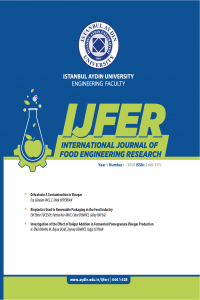THE EFFECT OF PROCESSING TECHNOLOGIES ON LYCOPENE IN TOMATOES (Lycopersicon esculentum L.)
THE EFFECT OF PROCESSING TECHNOLOGIES ON LYCOPENE IN TOMATOES (Lycopersicon esculentum L.)
Lycopene is a natural pigment of carotenoid family and recent years there is an increasing interest for the
health benefits of lycopene. Tomato and tomato products are considered as one of the most important source
of lycopene. The aim of this study is to determine the amount of lycopene in different tomato products such
as fresh tomatoes, ketchup, tomato juice, dried tomatoes and tomato paste. It is also aimed to determine the
effect of tomato paste processing on lycopene. In this study, lycopene values were found in the range of
89.14 - 581.35 mg/kg during processing at 5 different stages. The ranking of lycopene values found to be
as follows: evaporator ˃ the final product (tomato paste) ˃ shredder ˃ fresh tomatoes ˃ preheating stage.
Lycopene amount was low (89.14 ± 1.476 mg/kg) at preheating stage, while the highest lycopene value was
found at evaporation stage (581.35 ± 11.795 mg/kg). Among all the examined tomato products, lycopene
values were found in the range of 88.56 - 550.30 mg/kg in the order of : The final product (tomato paste) ˃
50% dehydrated tomato ˃ 70% dehydrated tomato ˃ ketchup ˃ tomato juice. Tomato juice found to have
low lycopene (88.56± 2.566 mg/kg), while the final products of tomato paste have the highest value (550.30
± 46.75 mg/kg). In addition, some the quality properties of the products have also been examined and the
following results were obtained: Soluble dry matter 28.01 – 28.27 °Brix, pH 4.06 – 4.52, total acidity 0.07
– 1.13g/100g, ash 0.41 – 13.38 %, color (a/b rate) 1.82 – 2.45, viscosity 3.57 – 4.03, invert sugar at total
dry matter 42.29 – 322.97%; and black spot 0 /10g. Considering the quality parameters of all samples, it
was determined that the result of chemical and physical analyses were in conformity with values defined in
Turkish Standards (TS 1466 Tomato Paste - Puree, TS 5282 Ketchup, TS 1595 Tomato juice and TS 3926
Dehydrated Tomatoes)
Keywords:
Tomatoes, , lycopene, , antioxidant activity , tomato products,
___
- [1] Günay, A.,2005. Vegetable growing. V:II, Special Vegetable Breeding, İzmir, 531.
- [2] Sönmez, K., ve Ellialtıoğlu, Ş.Ş., 2014. Tomatoes, Carotenoids and A review on factors that affect those. Harvest, 31 (2):107-130. Eskişehir Osmangazi University. Faculty of Agriculture. Department of Horticulture ,Eskişehir. Ankara University Faculty of Agriculture. Department of Horticulture, Ankara.
- [3] Yılmaz, İ., 2010. Some Foods Containing Antioxidants and Oxidative Stress. İnönü University. Faculty of Medicine Journal 17 (2) 143-153.
- [4] Gould, W.A., 1983.Tomato Production, Processing and Quality Evaluation. Avi Publishing Company, Inc., Westport, Connecticut.
- [5] Bramley PM., Review. Is lycopene beneficial to human health. Phytochemistry. 54(3): 233-6. (2000).
- [6] Sahlin, E., Savage, G.P., Lister, C.E., 2004. Investigation of the antioxidant properties of tomatoes after processing. Journal of Food Composition and Analyses. 17:635-647.
- [7] Hobson, G., Grierson, D., 1996. Tomato, Biochemistry of Fruit Ripening, Seymour, G.B., Taylor, J.E. and Tucker, G.A.(Eds), 403-414,Chapman and Hall, London.
- [8] Porrini M, Riso P. 2005. What are typical lycopene intakes? J Nutr 135(8):2042S-5S.
- [9] Omoni, A.O. and Aluko, R.E. 2005. The anti-carcinogenic and anti-atherogenic effects of lycopene a review. Trends Food Sci. Technol., 16; 344-350.
- [10] Benton Jones, J., 2007. Tomato Plant Culture: In the Field, Greenhouse, and Home Garden, Second Edition. CRC Press, 404 pp.
- [11] Gartner, C., Stahl, W. and Sies, H. 1997. Lycopene is more bioavailable from tomato paste than from fresh tomatoes. Am. J. Clin. Nutr., 66; 116-122.
- [12] Bıçaklı, D.H.,Uslu, R., 2012. Lycopene and Cancer. Ege University Faculty of Medicine. Turkish onkoloji journal. 27(2):93-97.
- [13] Everson KM, and McQueen CE. 2004. Lycopene for prevention and treatment of prostate cancer. Am J Health Syst Pharm;61(15):1562-6.
- [14] Duthie, G.G., Wahle, K.W.J. and James, W.P.T. 1989. Oxidants, antioxidants and cardiovascular disease. Nutrition Research Reviews, 2, 51–62.
- [15] Deming, D.M. and Erdman, J.W. 1999. Mammalian carotenoid absorption and metabolism. Pure and Applied Chemistry, 71, 2213–2223.
- [16] Sommerburg, O., Keunen, J.E.E., Bird, A.C. and van Kuijk, F.J.G.M. 1998. Fruits and vegetables that are sources for lutein and zeaxanthin: the macular pigment inhuman eyes. British Journal of Ophtalmology, 82, 907–910.
- [17] Matulka, R.A., Hood, A.M., Griffıths, 2004. Safety evaluation of a natural tomato oleoresin extract derived from food-processing tomatoes. Regulatogy and Pharmacology, 39:390-402.
- [18] Çernişev, S. ve Şleagun, G. 2007. Influenceof Dehydration Technologies on Dried Tomatoes Biological Quality And Value, Cercetari Agronomice In Moldova
- [19] Artık, N. 2003. Ergosterol Level in Tomato Paste and Change During Processing. Ankara University. Scientific Research Project Final Report
- [20] Anonymous,1990. Akpınar Agricultural Production and Canning A.Ş.(AKFA), Educatıonal Publıcatıons. Balıkesir.
- [21] Anonymous, 1983. Turkish Standardization Institute. Food Materials Inspection and Analysis Methods Book, Food Ingredients. Ministry of Agriculture Forestry and Rural Affairs, Food Works. General Directorate. General Broadcast Number: 65, 796 s., Ankara.
- ISSN: 2149-5777
- Başlangıç: 2015
- Yayıncı: İstanbul Aydın Üniversitesi
